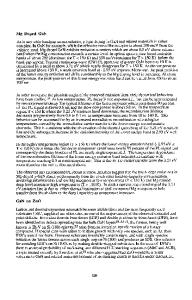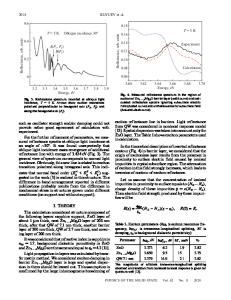Sensing properties of pellets based on mesoporous structures of ZnO
- PDF / 390,865 Bytes
- 7 Pages / 432 x 648 pts Page_size
- 14 Downloads / 335 Views
Sensing properties of pellets based on mesoporous structures of ZnO R. Herrera-Rivera1, A. M. Pineda1, M. de la L. Olvera1,2 and A. Maldonado1,2 1 Programa de Doctorado en Nanociencias y Nanotecnología, Centro de Investigación y de Estudios Avanzados del Instituto Politécnico Nacional. México, D.F., MEXICO 2 Departamento de Ingeniería Eléctrica, Centro de Investigación y de Estudios Avanzados del Instituto Politécnico Nacional. México, D.F., MEXICO
ABSTRACT Mesoporous zinc oxide nanopowders were synthesized by the homogenous precipitation method. Zinc acetate dissolved in water, at different molar concentrations, was used as Zn precursor, whereas ammonium carbonate ((NH4)2CO3) and ammonium hydroxide (NH4OH) were used to prepare the precipitant solutions. The precipitated powders were dried in a conventional drying chamber at 100°C for 1 h, and then calcined at 400°C during 2 h. Crystal structure of powders was determined by X-ray Diffraction (XRD), and the crystallite sizes were calculated from Scherrer’s formula. Morphological characteristics (size and shape) were analyzed from Scanning Electron Microscopy (SEM). The surface area and the pore volume were obtained from BET analysis. The hexagonal wurtzite phase was corroborated in all synthesized powders, irrespective of the synthesis conditions. From SEM micrographs different structures, depending on the experimental routes, were observed. In order to test the sensing properties of the ZnO nanopowders, 10 mm diameter pellets were manufactured and then measured in a propane (C3H8) atmosphere at different gas concentrations and temperatures. Pellets processed from ZnO powders at 0.05, 0.35, and 0.5 M presented the highest sensitivity, 413, 532, at 300°C and 500 ppm of C3H8. INTRODUCTION Different metal oxide semiconductors (MOS) have been used as chemo-resistive sensors, for example: SnO2, TiO2, In2O3, and ZnO among others [1]. Zinc oxide is n-type native semiconductor, chemically stable in wurtzite phase, with a large bandgap, around 3.37 eV at room temperature. In thin film form, present a high optical transparency, as well as a high electrical conductivity when it is doped with the adequate impurities [2-3]. These physical properties make ZnO a good candidate for different optoelectronic applications, for example as antireflective and piezoelectric layers [4 ], light emission diodes (LEDs) [5], thermal mirrors [6], liquid crystal displays (LCDs) [7], and chemical gas sensors [8], among others. Additionally, ZnO is used in pharmaceuticals and/or cosmetics applications like sunscreen protectors, acne treatment, or as antiseptic in ointments [9]. According to the required properties, ZnO thin films can be processed from different synthesis techniques, such as pyrolysis spray [10], sputtering [11], pulsed laser deposition [12], and sol-gel [13]. However for sintering ZnO powders only few methods have been reported in the literature, among these is the homogeneous precipitation method [14]. This method is a simple and low cost route; nevertheless it conduces to a high
Data Loading...









